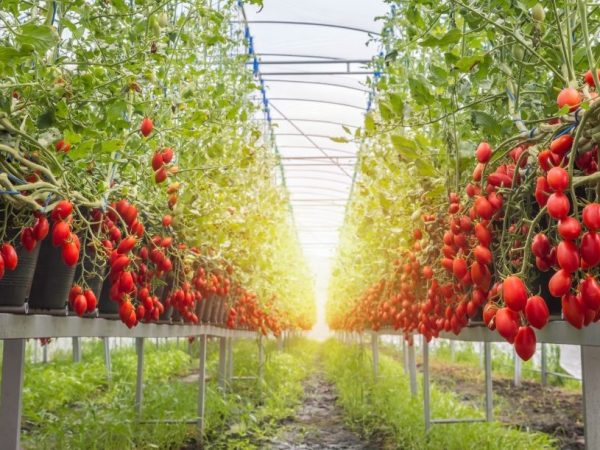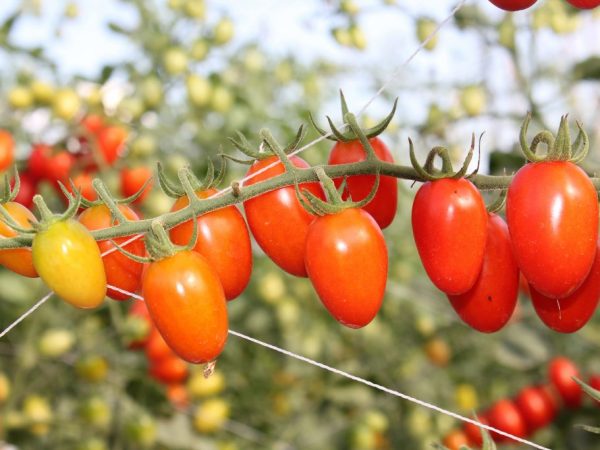Characteristics of the variety of tomatoes Octopus cream
It is difficult to surprise farmers with new varieties, but the Octopus cream tomato is an exception to this rule. Tomatoes of this variety grow on a tree that can grow up to 4 m in height. The plant also has an amazing liana-like structure, its branches spread out to the sides by 5-6 m.

Characteristics of the variety of tomatoes Octopus cream
Description of the tomato tree
Tomatoes Octopus cream is a tall hybrid, therefore, the addition "F1" is often attributed to its name.
This variety of tomatoes is not a tree in all its characteristics (although, according to external data, one can argue with this). Octopus Cream is an indeterminate bush with branches growing up to several meters. The plant also has a developed root system.
The tomato has small dark green leaves. Fruits grow on it in large clusters of 6-12 pieces.
The shape of the fruit is oblong, the color depends on belonging to a certain hybrid type. Most often, red fruits are found, but sometimes you can find raspberry or chocolate tomato. The skin is dense, rarely cracking.
Each fruit has a mass of 30-50 g, it has the usual multi-chamber structure, elastic, but juicy pulp. In terms of taste, such a tomato is not inferior to other well-known varieties.
The tomato bush is very fertile; no hybrid form of tomatoes can compare with the yield indicators of this variety. With proper care, 10-15 kg of tomatoes per year are obtained from one tree. Octopus bears fruit for a long time: from mid-summer to the end of October. The first harvest is most often at the end of July, but ovaries can form in early autumn. When grown in a greenhouse, the second crop has time to ripen.
Growing features
Only people living in warm climates can afford to plant Octopus tomatoes with seeds. Any of the two planting materials are sold in specialized stores and markets. There you can also buy special soil mixtures for growing tomatoes.
Sowing seeds
Growing seedlings from seeds occurs according to a number of rules:
- sowing seeds is carried out in December-January;
- planting material is germinated in a greenhouse at a temperature of 22 ° C to 25 ° C;
- organize daylight hours, if necessary, supplement planting with phytolamp;
- keep warm using a heater installed near the seedling growing area.
With proper care, young seedlings in a few weeks reach 7-9 cm in height and the first leaves appear on them. Seedlings should get used to external conditions - with the spring warming, they are already taken out into the street, gradually increasing the period of "walking".
Transplanting into a greenhouse or into open ground is carried out no earlier than June.
Transplant and further care

The plant does not need pinching
In summer, ready-to-transplant seedlings reach 20-30 cm in height. All that remains is to choose the best place to grow it:
- it should be sunny, protected from drafts;
- the soil must be fertile, including organic fertilizers;
- it is necessary to allocate a large area for planting, since the seedlings are distributed over the site at a distance of 1.5 m from each other.
The planting process itself is simple: holes are pulled out in the ground with a depth of 18-20 cm, the main root of the plant is pinched, after which the seedlings themselves are placed in the recesses. When burying a seedling, sprinkle it with earth and its lower leaves.
Caring for tomatoes includes regular feeding, pinching, and watering. A distinctive feature of the Octopus cream variety is that this tomato does not need pinching.
Positive and negative qualities
F1 cream is a moody plant, so its description includes both merits and demerits. Among the advantages are noted:
- High productivity. If 3-4 trees are planted on the site, the gardener can get up to 80 kg of tomatoes.
- Long-term fruiting (2 to 4 months).
- Early ripening of fruits.
- Good immunity to diseases and parasites.
The hybrid feels most comfortable in greenhouses or hotbeds. It is possible to grow it on the street, but it is extremely difficult to achieve the same yield indicators. In addition, the hybrid does not tolerate the cold, as a result, it is planted outdoors only in southern regions with mild winters.
Seeds of annual hybrid forms of tomatoes Octopus Cream are available commercially, but growing them at home has many nuances that cannot be fulfilled.
Conclusion
Perennial trees are grown on an industrial scale. Agrotechnical measures are performed according to standards that an ordinary amateur cannot use. Those interested in the complex cultivation of perennial tomatoes should carefully study both the characteristics of the variety and its agricultural technology.


